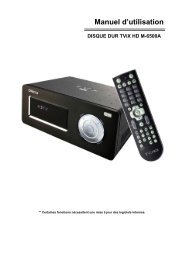MECABLITZ 50 AF-1 digital - Materiel.net
MECABLITZ 50 AF-1 digital - Materiel.net
MECABLITZ 50 AF-1 digital - Materiel.net
You also want an ePaper? Increase the reach of your titles
YUMPU automatically turns print PDFs into web optimized ePapers that Google loves.
�<br />
2. Dedicated flash functions<br />
Dedicated flash functions are flash functions that have been specially adapted to<br />
a given camera system. Depending on the type of camera, different flash functions<br />
are supported.<br />
2.1 Division into camera groups<br />
Nikon cameras can be subdivided into the following groups with regard to<br />
their dedicated flash functions:<br />
Cameras from Group A Cameras without <strong>digital</strong> data transfer to the<br />
flash unit<br />
e.g. Nikon F601, F601M, F60, F<strong>50</strong>, FM-3A<br />
Digitale Kompaktkameras “Nikon - Coolpix”<br />
Cameras from Group B Cameras with <strong>digital</strong> data transfer to the flash<br />
unit<br />
e.g. Nikon F4, F4s, F801, F801s<br />
Cameras from Group C Cameras with <strong>digital</strong> data transfer to the flash<br />
unit and 3D multi-sensor fill-in flash mode<br />
e.g. Nikon F5, F100, F80, F70,<br />
Cameras from Group D Digital Nikon single-lens reflex cameras with<br />
D–TTL flash mode (without CLS)<br />
e.g. D1, D1x, D1H, D100, Fuji FinePix S3Pro<br />
Cameras from Group E Digital Nikon SLR cameras with i-TTL flash mode<br />
(CLS compatible Cameras)<br />
e.g. D40, D<strong>50</strong>, D70, D70S, D80, D90, D200,<br />
D300, D2Hs, F6, D2x, D3, Coolpix 8400,<br />
8800, D3000, D<strong>50</strong>00, S5Pro<br />
Table 1<br />
1) not with Coolpix cameras<br />
90<br />
Camera Group Dedicated Flash Functions<br />
AB C D E<br />
• • • • • Flash-ready indicator in camera viewfinder/camera display<br />
• • • • • Correct exposure indicator in camera viewfinder /camera display<br />
• • • Underexposure indicator EV in LC display of the flash unit<br />
• • • • • Automatic flash sync speed control<br />
• • • TTL flash control Standard TTL without measuring preflash)<br />
• • • • • Automatic fill-in flash control<br />
• • Matrix-controlled TTL fill-in flash mode<br />
• 3D multi-sensor fill-in flash mode<br />
• D-TTL and D-TTL 3D flash mode<br />
• i-TTL and I-TTL-BL flash mode<br />
• Flash exposure measurement memory for i-TTL and I-TTL-BL1) • • • • Manual TTL/D-TTL/i-TTL flash exposure correction<br />
• • • 1st or 2nd curtain synchronisation (REAR)<br />
• Automatic FP short sync for i-TTL, I-TTL-BL and M<br />
• • • • Automatic motor zoom control<br />
• • • • Extended zoom mode<br />
• • • • • Automatic <strong>AF</strong> measuring beam control<br />
• • • • Automatic flash range indicator<br />
• • • • • Programmed auto flash mode<br />
• • • Preflash for red-eye reduction<br />
• • • Triggering control / auto flash<br />
• Wireless remote flash mode<br />
(Advanced Wireless Remote Flash Mode Lighting)<br />
• • • • • Wake-up function for the flash unit<br />
☞<br />
It is impossible to describe all camera types and their individual dedicated<br />
flash functions within the scope of these instructions. Therefore, please refer<br />
to the flash mode description in your camera’s operating instructions to find<br />
out which functions are supported and which ones have to be set manually<br />
on the camera. Using lenses not equipped with a CPU (i.e., lenses without<br />
auto focus mode), results in certain functional limitations.





